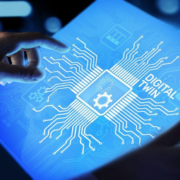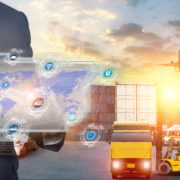The Dawning of 5G
As the digitization of industry and the global economy continues, a necessity for reliable, faster and more secure networks to connect businesses and the global supply chain continues to grow.
It is no surprise then that major companies and service providers, such as IBM and Vodafone, are forming joint-venture initiatives to test and develop a 5G ecosystem which, according to President of Mobile Networks with Nokia, Tommi Uitto, can generate new potential for automated operations and artificial intelligence.
While the worldwide implications of 5G technology are myriad, with leading companies Nokia and China Mobile seeking to create a more open and interoperable form of architecture for high-speed networks, its application to the ports and terminals sector could be game-changing.
As Dr. Yvo Saanen, Founder of simulation specialists TBA Group explains above, there is a need to connect a port’s assets, machines and people to systems, thereby increasing the safety and efficiency of cargo-handling operations.
The ability of 5G to optimize operations and “transmit data safely within milliseconds” is already being trialled as part of the Wireless for Verticals (WIVE) research project, one of many initiatives demonstrating the technology’s value as a catalyst for improved performance.
Faster and Smarter Networks
It would be easy to focus on the speed of 5G alone, especially when the development of this technology is likely to produce much shorter network response times for a wide variety of industries, including the logistics and port sectors.
However, as the University of Surrey’s world-leading 5G Innovation Centre underlines, the next evolution of connectivity is more significant than catering to the individual needs of everyday consumers: 5G is as much about “machine-to-machine” as it is “people-to-people”.
The flexibility of 5G networks, to “evolve, adapt and grow” is vital to the progress and implementation of this next technological phase which will allow applications to perform the “bandwidth-heavy” tasks demanded in the future.
Other benefits of 5G, as explored by key industry players like Nokia, include its prediction capabilities, security and reliability, positioning the technology as a crucial foundation for the development of machine learning tools.
Marc Rouanne, the ex-President of Mobile Networks at Nokia, once stated that “AI and machine learning will enable a myriad of new service opportunities”, in addition to reducing end user costs and minimizing the consumption of energy.
Revolutionizing Ports
Like a whole host of other industries seeking to ride the wave of digitization, businesses in the maritime sector, such as service providers, are hoping to leverage 5G to their collective benefit.
Kalmar, a provider of lifting solutions, is already trialling 5G applications and building a “technology road map” that will make the next stage of connectivity part of the “industrial standard of the future”.
Forecasting the revolutionary potential of 5G, Kalmar’s Director of Automation Research Pekka Yli-Paunu has predicted that “advances in connectivity give us the opportunity to develop the next generation of remote control that may utilise not only video, but audio and haptics as well”.
In addition to this, major ports are conducting their own 5G trials, testing its capability to drive advancement in other areas and provide a bedrock for smarter, more efficient operations.
The Port of Hamburg has already hailed the success of their project, with intermediate results indicating that “5G enables new types of mobile applications for the Hamburg Port Authority’s business”.
Looking ahead, Hamburg has isolated “5G network slicing” as an area that will have a particular impact on operations, laying the “foundation for new IoT applications” and “business models” that will boost the competitiveness of the entire port industry.
Unlocking the Potential
The cooperation of key players from multiple industrial and technological fields is currently forming an access point to 5G for businesses in all sectors.
Nokia has emphasized their work with “a lot of partners in the ports and terminals space, such as Konecranes, to enable the development of a connected ecosystem,” with the company “well positioned to understand the applications and savings made possible by mission-critical wireless technologies”.
According to Nokia’s statistics, ports and harbours make up a significant proportion of its vertical enterprise customers, all of which are currently deploying private LTE networks for their operational campus needs.
In the case of ports like HaminaKotka (located in Finland) the focus of “operational needs” once again shifts to connectivity, correlating to the intelligent machine Dr. Yvo Saanen imagines in his assessment of 5G.
Based on the sound situational awareness of container handling, warehouse logistics, and port security which machine-to-machine and machine-to-person connectivity offers, operations can be improved across multiple areas, from safety and efficiency to environmental performance and cost-effectiveness.
The extent of 5G’s potential impact on ports and terminals is still uncertain, but as operators and service providers search for smarter solutions, and ways to leverage automated technologies, the key word for the future is connectivity.
Source: Port Technology








